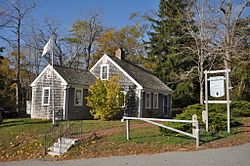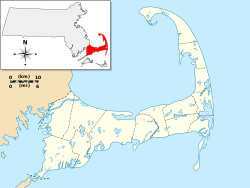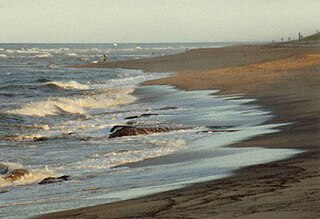
Cape Cod is a peninsula extending into the Atlantic Ocean from the southeastern corner of Massachusetts, in the northeastern United States. Its historic, maritime character and ample beaches attract heavy tourism during the summer months. The name Cape Cod, coined in 1602 by Bartholomew Gosnold, is the ninth oldest English place-name in the U.S.

Mashpee is a town in Barnstable County, Massachusetts, United States, on Cape Cod. The population was 15,060 as of 2020. The town is the site of the headquarters and most members of the Mashpee Wampanoag Tribe, one of two federally recognized Wampanoag groups.

Sandwich is a town in Barnstable County, Massachusetts, United States and is the oldest town on Cape Cod. The town motto is Post tot Naufracia Portus, "after so many shipwrecks, a haven". The population was 20,259 at the 2020 census.
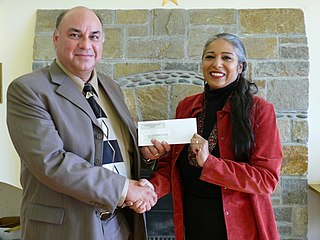
The Wampanoag, also rendered Wôpanâak, are a Native American people of the Northeastern Woodlands currently based in southeastern Massachusetts and formerly parts of eastern Rhode Island. Their historical territory includes the islands of Martha's Vineyard and Nantucket.

Cotuit is one of the villages of the Town of Barnstable on Cape Cod in Barnstable County, Massachusetts, United States. Located on a peninsula on the south side of Barnstable about midway between Falmouth and Hyannis, Cotuit is bounded by the Santuit River to the west on the Mashpee town line, the villages of Marstons Mills to the north and Osterville to the east, and Nantucket Sound to the south. Cotuit is primarily residential with several small beaches including Ropes Beach, Riley's Beach, The Loop Beach and Oregon Beach.

A wetu is a domed hut, used by some north-eastern Native American tribes such as the Wampanoag. They provided shelter, sometimes seasonal or temporary, for families near the wooded coast for hunting and fishing. They were made out of sticks of a red cedar frame covered with either tree bark or mats made from grass or reeds.

The Chatham Windmill is a historic windmill at Chase Park in Chatham, Massachusetts. Built in 1797, it is one of the state's few surviving wooden windmills, and also one of the few still in working condition. The windmill was listed on the National Register of Historic Places in 1978.

The Old Indian Meeting House is a historic meeting house at 410 Meetinghouse Road in Mashpee, Massachusetts. Built in 1758, the meetinghouse is the oldest Native American church in the eastern United States. The building was listed on the National Register of Historic Places in 1998.

The Baxter Mill is a historic gristmill on Massachusetts Route 28 in West Yarmouth, Massachusetts. Built about 1710 and restored to working order in 1961, it is the only surviving 18th-century water-powered mill on Cape Cod. It is now a museum property owned by the town and operated by the Yarmouth Historical Commission. The mill was listed on the National Register of Historic Places in 1981.

The Yarmouth Camp Ground Historic District is a historic district encompassing a religious summer camp meeting ground in Yarmouth and Barnstable, Massachusetts. The core of the camp ground was purchased in 1863 by the Sandwich District Camp Meeting Association, a Methodist Episcopal organization, and was operated until 1939. The area contains a well-preserved collection of predominantly residential buildings built during this period; it was listed on the National Register of Historic Places in 1990.

The Blish-Garret House is a historic house located in Barnstable, Massachusetts.

The Forestdale School, also known as the Greenville School, is a historic one-room school building at 87 Falmouth-Sandwich Road in Sandwich, Massachusetts. The single story wood-frame structure was built in 1878, and is one of a small number of surviving district school buildings on Cape Cod. It has Greek Revival features, including gable end returns, and transom windows over the two entrances. The building was listed on the National Register of Historic Places in 1997.

The Dr. Edward Francis Gleason House is a historic house in Barnstable, Massachusetts, United States.

The Gideon Hawley House is a historic house along Massachusetts Route 28 near the Cotuit village of Barnstable, Massachusetts.

Native American tribes in Massachusetts are the Native American tribes and their reservations that existed historically and those that still exist today in what is now the Commonwealth of Massachusetts. A Narragansett term for this region is Ninnimissinuok.
The Mashpee Wampanoag Tribe is one of two federally recognized tribes of Wampanoag people in Massachusetts. Recognized in 2007, they are headquartered in Mashpee on Cape Cod. The other Wampanoag tribe is the Wampanoag Tribe of Gay Head (Aquinnah) on Martha's Vineyard.
Joan Tavares Avant, also known as Granny Squannit, is an educator, Mashpee Wampanoag tribal leader, historian, and writer living in Mashpee, Massachusetts. Avant served as the Mashpee Public School Director of Indian Education and was a founding Trustee of the Wôpanâak language immersion program. As a tribal leader, Avant has served as Tribal President, Tribal Housing Commissioner, Clan Mother, and Professional Tribal Elder. Her writer's credits include a long-running column in the Mashpee Enterprise, editing the National League of American Pen Women's newsletter, and People of the First Light (2010).
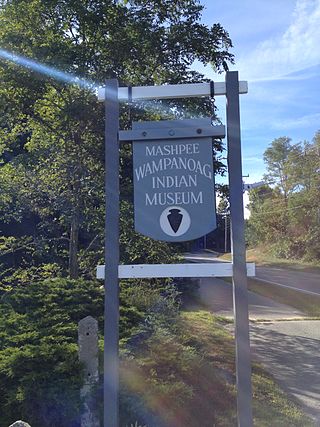
Mashpee Wampanoag Indian Museum is a cultural center in the town of Mashpee in Barnstable County, Massachusetts, United States. The town of Mashpee is the location of the Mashpee Wampanoag Tribe, one of the two federally recognized representative bodies of the Wampanoag people. The museum ground itself is well known for the Avant House as well as hosting the Mill Pond Herring Ladder, a Fish ladder on the Mashpee River. Establishing the museum was a passion project of Amelia Peters Bingham. The idea for the museum first came in 1970, but the building was only transferred to the Wampanoag Tribal Council after a unanimous vote to do so during the Mashpee town government's annual meeting in 1997. Since 1999 the site has been listed under the National Register of Historic Places.
Nelson Drue Simons (1885-1953) was a Mashpee Wampanoag Tribe chief from 1916 to 1928 and government official who was also the first known Native American graduate of Suffolk University Law School in Boston.
Ebenezer Quippish (1859-1933) was a leader of the Mashpee Wampanoag Tribe in Mashpee, Massachusetts. He was known for helping to led a cultural revival in Mashpee in the 1920s, and was also a traditional basket weaver, chef, hunting/fishing guide, seaman/whaler, and member of Buffalo Bill's Wild West Show.
